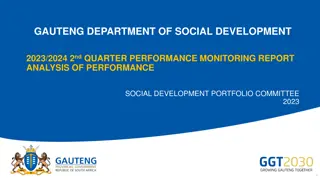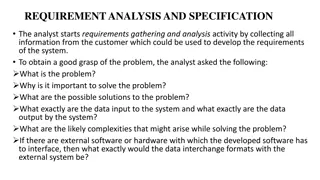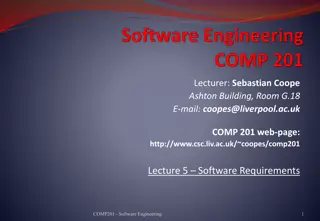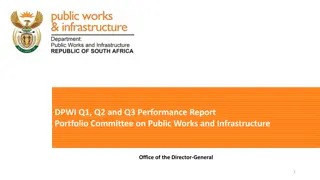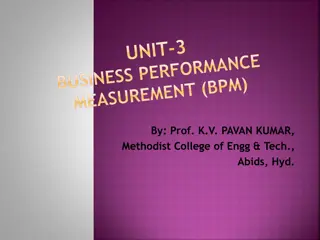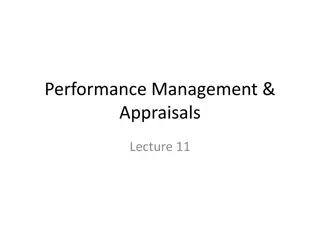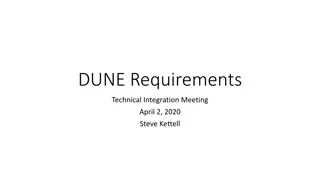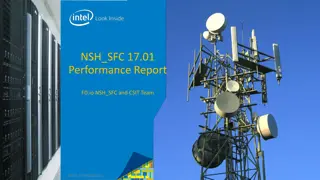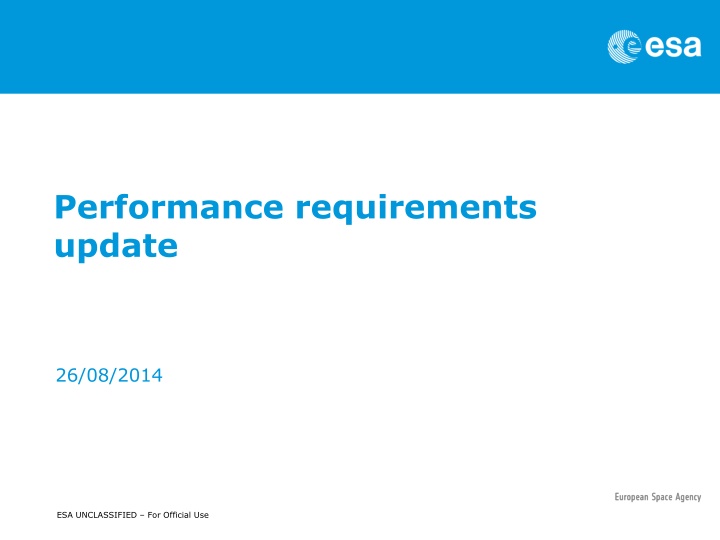
Enhanced GNSS Performance Requirements Update 26/08/2014
Explore the updated performance requirements for GNSS systems, covering aspects like position accuracy, time-to-first-fix, robustness to interference, and more. Get insights into new values, user dynamics, and jammer scenarios to enhance GNSS functionality.
Download Presentation

Please find below an Image/Link to download the presentation.
The content on the website is provided AS IS for your information and personal use only. It may not be sold, licensed, or shared on other websites without obtaining consent from the author. If you encounter any issues during the download, it is possible that the publisher has removed the file from their server.
You are allowed to download the files provided on this website for personal or commercial use, subject to the condition that they are used lawfully. All files are the property of their respective owners.
The content on the website is provided AS IS for your information and personal use only. It may not be sold, licensed, or shared on other websites without obtaining consent from the author.
E N D
Presentation Transcript
Performance requirements update 26/08/2014 ESA UNCLASSIFIED For Official Use
Overview 1) Horizontal Position Accuracy 2) Vertical Position Accuracy 3) Availability of Required Accuracy 4) GNSS Time Accuracy 5) Time-to-first-fix 6) Position Authenticity 7) EMI Localisation Accuracy 8) Robustness to Interference 9) GNSS-Denied Accuracy 10) GNSS Sensitivity 11) Position Integrity Protection Level 12) Position Integrity Time-to-Alert (TTA) 13) Position Integrity Time-to-Recover-from-Alert Jeremie/Kevin Jeremie/Kevin ? Jeremie Paolo Marco Marco Paolo Kevin Paolo/Jeremie Paolo Paolo ? ETSI - STF474 | 26/08/2014 | TEC-ETN | Slide 2 ESA UNCLASSIFIED For Official Use
Time-to-first-fix (PAR#5) 1. New values for other receiver classes (stand-alone GNSS and A-GNSS) 2. New user dynamics (pedestrian) for indoor environments according to 5.1.2.1 (table 5.1 to be amended with a column for indoor/outdoor) 3. Tables updated ETSI - STF474 | 26/08/2014 | TEC-ETN | Slide 3 ESA UNCLASSIFIED For Official Use
Robustness to Interference (PAR#8) 1. Jammer scenarios definition 2. Identification of applicable classes of positioning terminals for simulations 3. Performance parameters definition 4. Post-processing of the results and minimum performance requirements derivation for the applicable classes ETSI - STF474 | 26/08/2014 | TEC-ETN | Slide 4 ESA UNCLASSIFIED For Official Use
Jammer scenarios 1. Based on PPDs (Personal Privacy Devices) surveys available on literature a. D. Borio, J. Fortuny-Gausch and C. O Driscoll "Characterization of GNSS Jammers", Coordinates, Vol. XI, Issue 5, May 2013, pp. 8-16 T. Kraus et al., Survey of In-Car Jammers Analysis and Modeling of the RF Signals and IF Samples (Suitable for Active Signal Cancelation), Proceedings of ION-GNSS 2011 September 2011 Mitch, R. H., Dougherty, R. C., Psiaki, M. L., Powell, S. P., O Hanlon, B. W., Bhatti, B. W. and Humphreys T. E. (2011). Signal characteristics of civil GPS jammers. Proceedings of the 24th International Technical Meeting of The Satellite Division of the Institute of Navigation (ION/GNSS), pages 1907-1919, Portland, OR. b. c. Pullen, S. and Gao G. (2012). GNSS jamming in the name of privacy. Inside GNSS, pages 34-43. 2. Chirp signals with different characteristics d. No. Class Bandwidth Sweep time(s) PPeak [dBm] Center frequency 1.5747594 GHz 1.57507 GHz 1.58824 GHz 1.5744400 GHz 1.57130 GHz 1 2 3 4 5 I II II I III 0.92 kHz 11.82 MHz 44.9 MHz 0.92 kHz 10.02 MHz - TSW = 11.71 s TSW = 18.97 s - TSW1 = 8.7 s (TSW1,up = 6.8 s, TSW1,down = 1.9 s) TSW2 = 34.8 s TSW1 = 8,7408 s TSW4,1 = 1.1215 ms TSW2 TSW4,2 = 1.3557 ms TSW3 = 139.9 183.7 s TSW4,3 = 2.2825 ms TSW = 8.62 s -12.1 dBm -14.4 dBm -9.6 dBm -25.6 dBm -19.3 dBm 6 IV -9.5 dBm 1.57317 GHz (1.57723 GHz) 11.31 MHz ( 19.43 MHz) = 43.78 s 7 II 1.57194 GHz 10.72 MHz -30.8 dBm ETSI - STF474 | 26/08/2014 | TEC-ETN | Slide 5 ESA UNCLASSIFIED For Official Use
Jammer position and relative power 1. Testing scenario defined as a repetition of N successive overtaking of the jammer 2. Relative power accounts for free space propagation losses and the initial jammer power Jammer Overtaking Class Bandwidth Peak [dBm] Center Frequency 1575.42 MHz Sweep time(s) 11.71 s -45 11.82 MHz -14.4 X: 3.003 Y: -45.94 Chirp signal with one saw-tooth function case 1 Chirp signal with one saw-tooth function case 2 -50 free space propagation Loss [dB] -55 44.9 MHz 18.97 s -9.6 1575.42 MHz -60 -65 3. relative Doppler is negligible if compared to the frequency range swept by the jammer 4. DoA of the jammer considered for Beam- forming antenna -70 X: 100 Y: -76.39 -75 -80 -150 -100 -50 0 50 100 150 Distance [m] ETSI - STF474 | 26/08/2014 | TEC-ETN | Slide 6 ESA UNCLASSIFIED For Official Use
Performance parameter definitions 1. Availability of the position fix 2. Accuracy degradation of the position fix in dependence of the interference power level (jammer distance and J/S) 3. Loss of lock and reacquisition probability according to the interference power level (jammer distance and J/S) ETSI - STF474 | 26/08/2014 | TEC-ETN | Slide 7 ESA UNCLASSIFIED For Official Use
Test results Test results with different high sensitivity receivers (only GPS L1) -160 dBm trk. Sensitivity and narrowband (can filter out part of the jammer power) 1. UBLOX: Ublox 5H, 5T 2. Mediatek MT3329 (Fastrax IT500) 3. STM TeseoII (Fastrax IT600) with notch filter 4. NOKIA N8 GPS 5. NovAtel OEM4 ETSI - STF474 | 26/08/2014 | TEC-ETN | Slide 8 ESA UNCLASSIFIED For Official Use
Single frequency position accuracy 1. The solution availability when the maximum J/S was around 25 dB was only 16% ETSI - STF474 | 26/08/2014 | TEC-ETN | Slide 9 ESA UNCLASSIFIED For Official Use
Applicable classes of terminals 1. Standard GNSS receiver single constellation 2. Standard GNSS receiver multiple constellation (the impact of the jammer is not the same at the same time on all the satellites different instantaneous spectral separation coefficients. It depends on the sweeping time of the jammer and on its bandwidth) 3. Standard GNSS receiver multiple constellation + Notch filters (expected gain of 5 dB) 4. Standard GNSS receiver multiple constellation + Notch filters + beam- forming antenna ETSI - STF474 | 26/08/2014 | TEC-ETN | Slide 10 ESA UNCLASSIFIED For Official Use
Notch filter analysis based on STM Teseo II 1. Multi-constellation receiver (GPS + Galileo + GLONASS) 2. notch filter to track and eliminate narrow-band interferers from the GPS/Galileo and GLONASS RF paths 3. Command to enable / disable notch 4. proprietary message that reports the current status of the notch filter indicating the intermediate frequency value tracked by the notch filter and estimated power of the interferer ETSI - STF474 | 26/08/2014 | TEC-ETN | Slide 11 ESA UNCLASSIFIED For Official Use
Beam forming antenna 1. Antenna Solutions: a. CRPA (Controlled Radiation Pattern Antenna) - null steering or sidelobe cancellation Adaptive Beamforming - beamforming the receiver antenna towards GPS satellites 2. Example (military applications) for Controlled Reception Pattern Antenna: Novatel GAJT (Anti-Jam Antenna) a. 7 antenna elements (Maximal 6 interferers simultaneous) b. Interference suppression 40 dB (typical) b. 3. Way-forward for simulation: a. definition of a beam-nulling or forming algorithm b. Computation of the beam and reduction of the Jammer and SV signals ETSI - STF474 | 26/08/2014 | TEC-ETN | Slide 12 ESA UNCLASSIFIED For Official Use
GNSS Sensitivity (PAR#10) 1. Defined scenarios based on AWGN channel with decreased GNSS SV signal power 2. Simulation to be finished ETSI - STF474 | 26/08/2014 | TEC-ETN | Slide 13 ESA UNCLASSIFIED For Official Use
Position Integrity Protection Level and Position Integrity Time-to-Alert (TTA) and (PAR#11 & 12) 1. To be completed (not yet started) ETSI - STF474 | 26/08/2014 | TEC-ETN | Slide 14 ESA UNCLASSIFIED For Official Use




